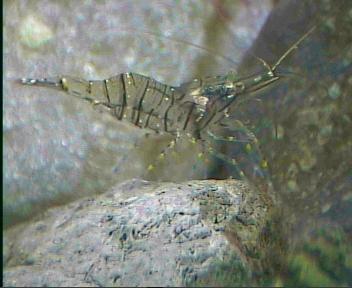Prawns in Britain |
||
| Perform a web
search on prawns and most of the results will be recipes! Prawns
and shrimps are fascinating creatures which perhaps deserve more
attention as living organisms.
There are more than 40 species of prawn to be found around the coast of Britain. The distinction between the name shrimp and prawn is not exact and in common parlance the naming tends to be contextual rather than scientific, e.g. Children collecting prawns on the beach will often refer to them as shrimps whereas their parents will call them prawns when purchased at the shop! From a taxonomic or scientific perspective, prawns can be referred to as "palaemonid prawns" and shrimps as "crangonid shrimps" though this is not exclusive as there are seven families of prawns and shrimps. In general, if it swims actively it is a prawn and if it scuttles, it is a shrimp though this a very simplistic view. Classification Phylum Arthropoda Class Crustacea Order Decapoda Supersection Natantia Section Caridea
Families Pasiphaeidae Palaemonidae Alpheidae Hippolytidae Processidae Pandalidae Crangonidae
Life Cycle
Most prawns and shrimps are dioecious(1) though there is evidence of males in some species changing sex at various times. Copulation usually occurs when the female has undergone a "copulation ready" molt. Spawning takes place shortly afterwards. Planktonic Zoea larvae hatch shortly afterwards undergoing a number of successive molts to develop into a post-larval stage. These "mini adult" stages then settle out of the plankton to begin final growth to maturity. Growth occurs through stages of molting. Prawns and shrimps have a rigid exoskeleton that protects the soft internal structure. The exoskeleton is periodically shed as the creature grows.
Feeding
Prawns and shrimps will eat zooplankton, small crustaceans, certain algae and carrion.
Habitat
Prawns and shrimps can occur in any marine habitat from brackish pools to the open sea. Crangonid shrimps, can be found buried in sand around estuaries and shores. The common brown shrimp, Crangon crangon, can be found by sifting through the top layer of sand with a flat fronted net.
|
Images Of
Prawns
Palaemon serratus Have a look at
|
|
| 1 Male and female reproductive organs in separate individuals | ||
